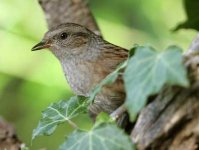So, what have we learned?
1. Some Meadow Pipits can have a strong supercillium. Such birds can, and do appear in various populations. [ Most of us knew that. ]
2. All Meadow Pipits have a pre-breeding moult. The timing may vary. [ Perhaps only ringers knew that, but it is mentioned in The Handbook, BWP, 'Svensson' etc. ]
3. Meadow Pipit migration has a double peak. The latter coinciding with White Wagtail passage in northwest England. There is a possibility that these birds may be
en route to the same breeding areas, but there is no hard proof. [ Until there is conformation, either way, anything else is 'blue sky thinking' ]
4. There is a suggestion that autumnal passage birds that are more brightly marked may originate in Iceland, but that is only opinion. Yet again, there is no hard proof. As Meadow Pipit are, almost, infinitely variable in regards to overall colour only a very long series of controlled birds from Iceland would prove, or disprove this. [
ditto ]
5. Some people don't half get ar*ed.

6. 52 posts and ........
Don't you just love BF. :t:





